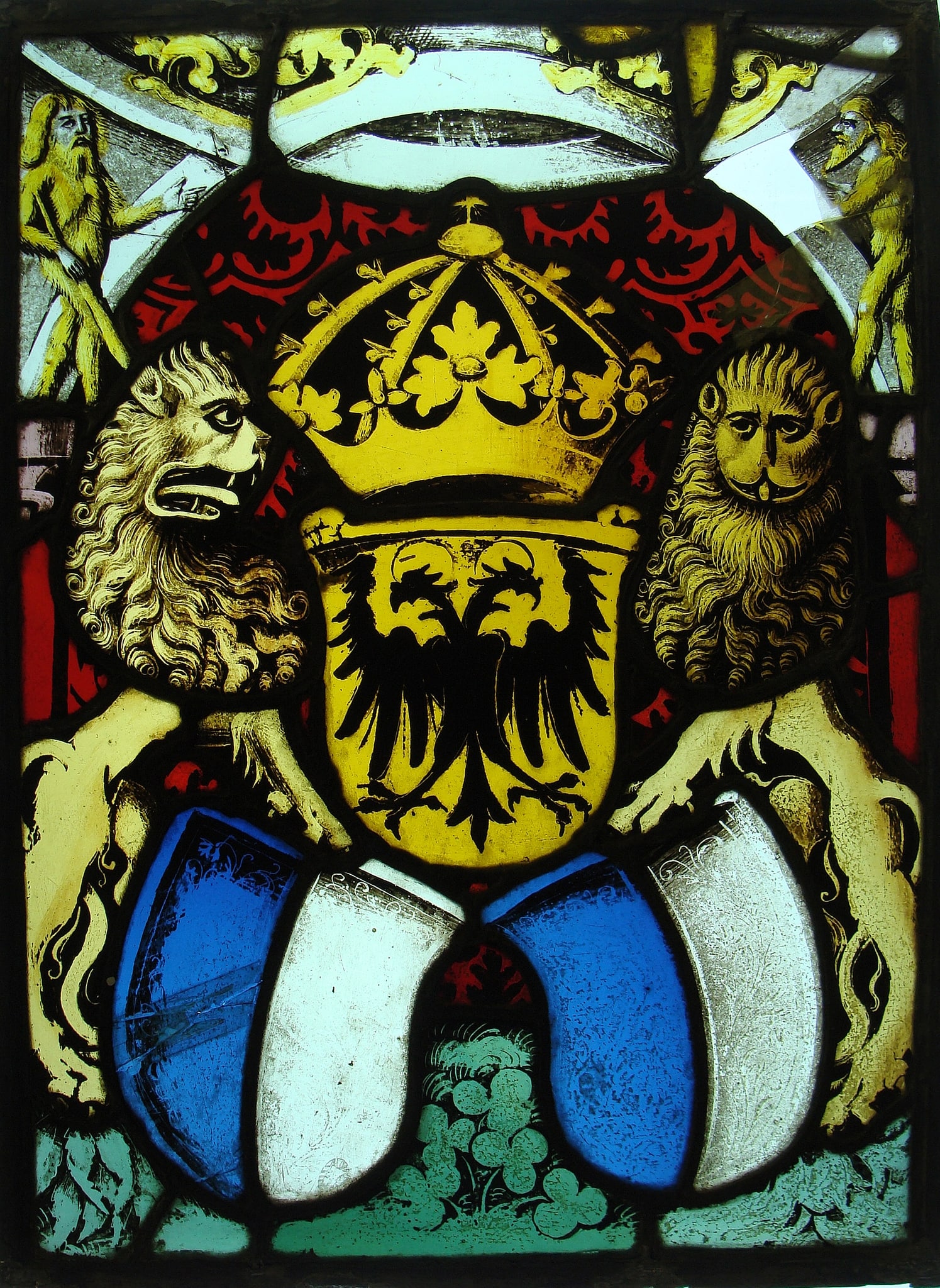The panel is an early example of the format for arms of Swiss cantons, called a Standesscheibe. The shields are arranged as a pyramid, two repeated arms leaning towards each other in heraldic courtesy at the base. The presence of the imperial arms refers to the status enjoyed by the members of the Swiss confederation after their defeat of the Hapsburg armies in the Battle of Sempach in 1385 (technically: Reichsfrei, enjoying special status granted within the empire). Flanking the shields are supporters; here, lions. The scene takes place within an architectural frame against a damascene backdrop. The vegetal foreground at the base of the panel is rendered without perspective. Centrally positioned between the Zurich shields are five individual clover leaves, which symbolize enduring health and vital life force for the inhabitants of Lucerne.
Hans Lehmann identified the Los Angeles panel as the work of the Lucerne artist Oswald Göschel (active 1491–1513) and suggested a date of 1495 (Lehmann, 1941, p. 15, pl. 9, fig. 13 with photo reversed). A comparison with another Standesscheibe for Lucerne by Göschel from about the same time shows a very different format (destroyed in war, formerly Kunstgewerbe Museum, Berlin; Lehmann, 1941, pp. 15–16, pl. 10, fig. 14). The latter panel is more elongated, and the youthful male and female supporters are more hemmed in by the architectural surround. The vigorous three-dimensionality of the architecture, however, with the angels perched on projecting socles and displaying different attitudes as they play their instruments, shows precisely the same conventions as the ribbed vaults with animated wildmen in the Los Angeles panel. The vigorous handling of the curly hair and feathered cap of the young man is similar to the energetic brush and stick work of the lions’ manes. Lehmann also associates the Los Angeles composition with a model used by Göschel’s contemporary, Wolfgang Intaler, an immigrant from Straubing in Bavaria, active in Lucerne from about 1480 to 1525. The compositional and stylistic affinities suggest additional associations. Lehmann argues that on his journey from Bavaria to Lucerne, Intaler must have spent time in the Zurich workshop of Lukas Zeiner, who was, in his view, “the best glass painter in the city.”
This context gives a striking importance to this panel. Indeed, the oldest models of the Standesscheibe for Lucerne are those of Intaler, (Schweizerisches Nationalmuseum, Zurich; Lehmann, 1941, p. 22, pl. 21, fig. 34; Schneider, 1970, p. 38, no. 41) and that of Göschel, in the Los Angeles County Museum of Art. Indeed, a comparison of the two shows Göschel’s as far more dynamic in composition and execution. Intaler presents a flat architectural frame relegating the lions to a backdrop, which hems them in. Göschel shows a three-dimensional vault with intersecting ribs, set with statues of wildmen on the capitals of the columns. Göschel's work is profiled by Lehmann in a discussion that includes analysis of twenty-five panels, all of which he illustrates. His comparative index begins with a group of four: Standescheiben, Bern, Zug, Freiburg, and Solothurn, produced in 1505 (Schweizerisches Nationalmuseum, Zurich; Lehmann, 1941, p. 16, pls. 11–12, figs. 15–18). Schneider discusses seventeen panels as either the work of Oswald Göschel or his workshop which she dates to about 1505 (Schneider, 1970, pp. 47–51, nos. 80–96). Boesch dates Göschel’s panel of Basel to 1500 (Boesch, 1955, pp. 72–77, fig. 17). All in all, Göschel’s work was a pioneering development in Swiss glass painting.
Göschel's composition parallels that of his more famous contemporary, Lukas Zeiner of Zurich (Boesch, 1955, pp. 70ff; Schneider, 1959; Lehmann, 1926, esp. pp. 62–71). Zeiner’s series from the Baden Town Hall, made in 1501 shows a similar format of shields held by heraldic supporters against damascene backgrounds and, above all, three dimensional architectural frames (PB_1–PB_7, SZ_3, BS_23, GE_2153). In the Baden series’ Standesscheibe of Zurich, the two lions display the same lean, erect body and billowing manes as the beasts in the Los Angeles work (Schweizerisches Nationalmuseum, Zurich 12804; PB_1). Both Göschel's and Zeiner’s panels are enlivened by the engaging figures perched on top of the capitals and moving out into space. This illusionistic effect imitates ornate, late Gothic city portal armorials with their symbolic guardians in the spandrels. The wild men on the capitals of the Los Angeles work parallel the confronting halberdiers from Baden. However much the compositions may be similar, the rendering of the design is quite distinct. Göschel's brushwork is much simpler and bolder, using broad strokes of wash as well as stick work to model the figures. Zeiner’s execution is much more studied and he is prone to add more surface ornament, such as damascene on the Imperial shield. His brushwork is tighter and more precise, frequently using a continuous outline in trace or stick work to enclose a form. Göschel's composition is the work of an artist who was fascinated by perspective settings, but in the early stages of the practice. The dominant placement of the crown and heraldic group to overlap and intersect the frame is a solution most common used before 1500, a composition governed by simplicity and clarity.
Cited in:
LACMA Quarterly, 1945, pp. 5–10.
Normile, 1946, pp. 43–44.
Hayward, 1989, p. 68.
Raguin, 2024, vol. 1, pp. 37, 115–18.
c. 1495
